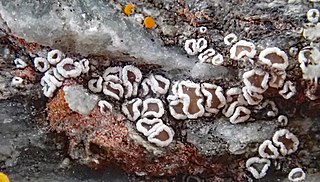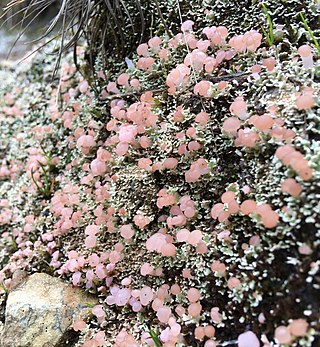
The Boletaceae are a family of mushroom-forming fungi, primarily characterised by small pores on the spore-bearing hymenial surface, instead of gills as are found in most agarics. Nearly as widely distributed as the agarics, the family is renowned for hosting some prime edible species highly sought after by mushroom hunters worldwide, such as the cep or king bolete . A number of rare or threatened species are also present in the family, that have become the focus of increasing conservation concerns. As a whole, the typical members of the family are commonly known as boletes.

Malassezia is a genus of fungi. It is the sole genus in family Malasseziaceae, which is the only family in order Malasseziales, itself the single member of class Malasseziomycetes. Malassezia species are naturally found on the skin surfaces of many animals, including humans. In occasional opportunistic infections, some species can cause hypopigmentation or hyperpigmentation on the trunk and other locations in humans. Allergy tests for these fungi are available. It is believed French revolutionary Jean-Paul Marat suffered from a fungal infection from Malassezia restricta, which lead to his frequent bathing in a medicinal substance.

The Baeomycetales are an order of mostly lichen-forming fungi in the subclass Ostropomycetidae, in the class Lecanoromycetes. It contains 8 families, 33 genera and about 170 species. As a result of molecular phylogenetics research published in the late 2010s, several orders were folded into the Baeomycetales, resulting in a substantial increase in the number of taxa.
Ainoa is a genus of lichens in the family Baeomycetaceae. The genus contains two species: A. mooreana, and the type, A. geochroa. The genus was circumscribed in 2001 by H. Thorsten Lumbsch and Imke Schmitt to contain the two species, which were formerly placed in genus Trapelia. A third species, Ainoa bella from eastern North America, was added to the genus in 2015.

Pilophorus is a genus of lichen-forming fungi in the family Cladoniaceae. They are commonly known as matchstick lichens. The genus has a widespread distribution, especially in temperate regions, and contains 11 species. The genus was circumscribed by Theodor Magnus Fries in 1857, with Pilophorus robustus assigned as the type species.

Endocarpon is a genus of saxicolous (rock-dwelling), crustose lichens in the family Verrucariaceae. The genus was circumscribed by German bryologist Johann Hedwig in 1789.

Allocetraria is a genus of lichenized fungi in the family Parmeliaceae. It consists of 12 species, with a center of distribution in China.

Hypogymnia is a genus of foliose lichens in the family Parmeliaceae. They are commonly known as tube lichens, bone lichens, or pillow lichens. Most species lack rhizines that are otherwise common in members of the Parmeliaceae, and have swollen lobes that are usually hollow. Other common characteristics are relatively small spores and the presence of physodic acid and related lichen products. The lichens usually grow on the bark and wood of coniferous trees.

Bulbothrix is a genus of lichen-forming fungi in the family Parmeliaceae. This genus is synonymous with Bulbothricella V.Marcano, S.Mohali & A.Morales. Bulbothrix was circumscribed by lichenologist Mason E. Hale in 1974 with Bulbothrix semilunata as the type species.

Lecidella is a genus of crustose lichens in the family Lecanoraceae.

Ophioparma is a genus of crustose lichens in the family Ophioparmaceae.
Megasporoporia is a genus of four species of crust fungi in the family Polyporaceae. The genus is characterized by its large spores, and dextrinoid skeletal hyphae.

The Agaricostilbomycetes are a class of fungi in the subdivision Pucciniomycotina of the Basidiomycota. The class consists of a single order, six families, and 15 genera. Its type genus, Agaricostilbum was originally placed in Ascomycota, and later, Agaricomycotina, before being placed in Pucinniomycotina.

Bryoria is a genus of lichenized fungi in the family Parmeliaceae. Many members of this genus are known as horsehair lichens. The genus has a widespread distribution, especially in boreal and cool temperate areas.
Aino Marjatta Henssen, was a German lichenologist and systematist. Her father, Gottfried Henssen, was a folklorist and her mother was Finnish.

Baeomyces is a genus of lichenized fungi in the family Baeomycetaceae. Members of Baeomyces are commonly called cap lichens. The genus was circumscribed by German mycologist Christiaan Hendrik Persoon in 1794. Although Persoon did not designate a type species in his original description of the genus, Frederick Clements and Cornelius Lott Shear assigned Baeomyces byssoides as the type in 1931.

Myriolecis is a genus of lichen in the family Lecanoraceae. It was originally circumscribed in 1909 by Frederic E. Clements with Myriolecis sambuci as the type species. The genus was later reinstated to accommodate the Lecanora disperse group and Arctopeltis. Molecular phylogenetic data showed that this group of species formed a clade that is genetically distinct from Lecanora, and Myriolecis was the oldest name available to hold these species.

Phyllobaeis is a genus of lichen-forming fungi in the family Baeomycetaceae. It has six species. The genus was circumscribed by lichenologists Klaus Kalb and Claudia Gierl in 1993, with Phyllobaeis imbricata assigned as the type species. Phyllobaeis differs from Baeomyces by the production of the secondary chemical norstictic acid, as well as the tropical distribution of its species. Most species have a squamulose thallus, but the most recent addition to the genus–the Chinese species P. crustacea–has a crustose thallus.
Allocetraria corrugata is a species of foliose lichen in the family Parmeliaceae. It is found in high-elevation locations in Yunnan, China, where it grows on rocks with mosses.
Placolecis is a genus of lichen-forming fungi in the family Catillariaceae. It has four species of saxicolous (rock-dwelling) and crustose lichens. The genus was circumscribed by Italian botanist Vittore Benedetto Antonio Trevisan de Saint-Léon in 1857. He did not assign a type species for the genus. Josef Hafellner designated a lectotype for Placolecis balanina in 1984, but subsequently, this taxon was folded into P. opaca.














